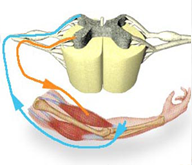Somatosensory Evoked Potential (SSEP)

Somatosensory Evoked Potential (SSEP) is a test showing the electrical signals of sensation going from the body to the brain. The signals show whether the nerves that connect to the spinal cord are able to send and receive sensory information like pain, temperature, and touch. When ordering electrical tests to diagnose spine problems, SSEP is combined with an electromyogram (EMG), a test of how well the nerve roots leaving the spine are working. An SSEP test will indicate whether the spinal cord or nerves are being pinched. This is extremely helpful in determining how damaged a nerve is and if there is a bone spur, herniated disc, or other source of pressure on the spinal cord or nerve roots. EMG is used to show if a nerve is being irritated or pinched as it leaves the spine on its way down the arm or leg. During spine surgery, the EMG is used to monitor nerve output to the muscles in procedures where screws are placed in the middle or lower part of the spine. SSEP is used to double check whether the sensory part of the nerve is working correctly.

To perform a SSEP, our trained technician will place an electrode over the skin and measurements of how long it takes an electrical signal to travel through the nerve pathway will be recorded. The function of the nerve is determined by the speed of these electrical signals. When the nerve pathway is pinched, the signals are slower than expected. An SSEP does not show why the problem occurred or what is causing it. The test looks primarily at whether sensation is affected by a problem in the spinal cord or nerves. There could be a problem in the nerve somewhere between the central nervous system and the area tested. The problem may not necessarily be in the spine itself.
